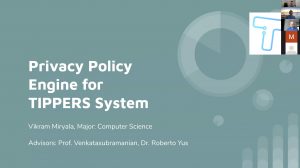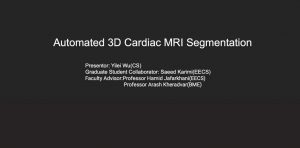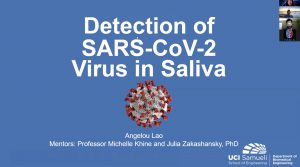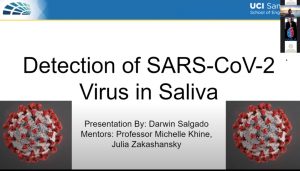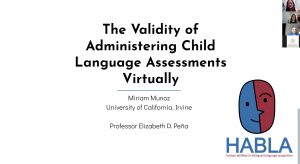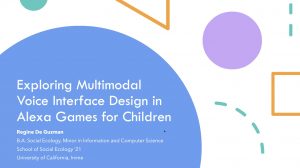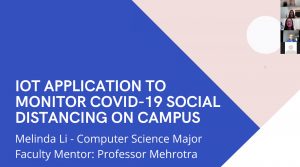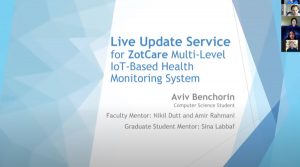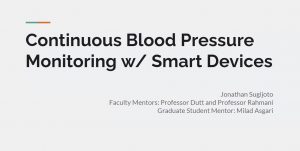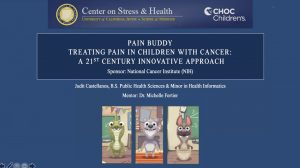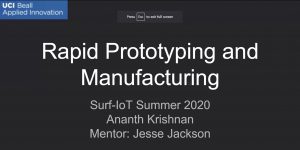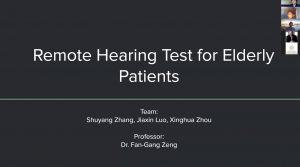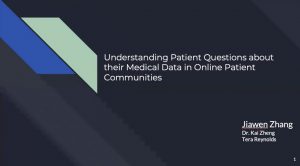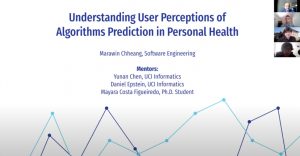Sept. 14, 2020
Summer Undergraduate Research Fellows in the Internet of Things (SURF-IoT) presented their projects Wednesday, Sept. 10, at the SURF-IoT Symposium held via Zoom.
Students shared the results of their 10-week research efforts by presenting final reports at the closing-day event.
The SURF-IoT program, co-sponsored by UCI’s Undergraduate Research Opportunities Program (UROP) and CALIT2, provides students with a unique experience. Each student has the guidance of a UCI faculty mentor, along with the opportunity to gain experience and advanced training in state-of-the-art facilities and techniques.
To learn more about SURF-IoT visit, https://www.urop.uci.edu/surf-it.html
View the SURF-IoT symposium program at: https://youtu.be/VqE4Qi186L0
A Privacy Policy Engine for the Internet of Things
Fellow: Vikram Miryala
Faculty Mentor: Professor Nalini Venkatasubramanian, Computer Science
Additional Mentors: Professor Sharad Mehrotra; postdocs Roberto Yus and Georgios Bouloukakis.
This project will take place in the context of our TIPPERS project. TIPPERS is a system that manages IoT smart spaces by collecting sensor data, inferring semantically meaningful information from it, and offering such inferences to developers to create smart applications. Sensor data collection, processing, and sharing leads to potential violations of people’s privacy given the sensitivity of the data and the inferences that can be extracted from it. For instance, just by collecting information about whether the lights are on or off in an office space it is possible to infer the location of individuals and from that location information other inferences can be made such as time spent in office.
Data privacy regulations, such as the European General Data Protection Regulation (GPDR) or the California Consumer Privacy Act (CCPA), are requiring companies to take user preferences into account when managing their data.
This project will deal with the design and development of a policy engine that takes people’s preferences into account at the time of collecting, processing, storing, and sharing data. The policy engine will support a policy language in which people can express such preferences and then implement them into the different phases of data flow into the TIPPERS system. As an example, if a user defines that her location data should not be shared with any application, this policy will have to be enforced when an application requests the data from the system.
The student will get an opportunity to study about implications on people’s privacy when dealing with sensor data. They will participate in the design of an extension to the current policy engine in TIPPERS with a team of multiple grad students. The student will also learn how to contribute to the development of an existing system through programming and documentation. The expected outcome is a module that will be incorporated into the TIPPERS system to handle different types of user privacy policies. This module will be tested in a real system deployed at our Computer Science building with dozens of users.
Applications of Deep Learning in 3D Cardiac MRI Segmentation
Fellow: Yilei Wu
Faculty Mentor: Professor Hamid Jafarkhani, Electrical Engineering & Computer Science
Over the past decade, the Cardiac MR (CMR) imaging technique is extensively used to monitor structural and functional heart condition for patients to facilitate more accurate diagnosis and treatment. Precise chamber segmentation is the main step toward analyzing the CMR data; however, manual segmentation by expert physicians and radiologists is a tedious and time-consuming task. Motivated by the recent success of deep learning in computer vision task, we proposed a deep learning framework for a 2D automated segmentation of heart chambers and provided a baseline result on a private set of CMR data.
Currently, we are working on expanding the results to 3D MRIs. We believe that our 2D methods and algorithms can be extended to 3D MRIs. To achieve this goal, we need to design 3D deep learning algorithms to automatically segment the 3D MRIs.
Continuous Physiological Monitoring for COVID-19
Fellow: Angelou Lao
Faculty Mentor: Professor Michelle Khine, Biomedical Engineering
Fever and cough are the earliest symptoms of COVID-19, followed by dyspnea approximately 6 days later. In addition to these patient-reported symptoms, physiological signals such as respiratory patterns, heart rate, and breath sounds are essential in guiding treatment and clinical decisions. Tele-monitoring and remote acquisition of physiological data from home would be especially useful in COVID-19 patients, both during the early stages of the disease with regards to hospital admission, as well as after discharge. We seek to continuously monitor these subtle physiological signals to monitor at-risk individuals (e.g. healthcare workers, cancer and chronic disease patients), detect early warning signs of clinical deterioration, as well as track the progression of illness. We have previously developed a low-cost, disposable, wireless sensor patch that can continuously monitor respiratory rate and tidal volume on ambulatory patients. Because these low-powered piezo-resistive sensors can be integrated with wireless Bluetooth units, they can be useful in monitoring patients with lung function in ambulatory settings. We have been developing these sensors to monitor asthma, but we can similarly apply it to monitor respiratory function in COVID-19 patients. We propose to integrate this respiration sensor with a simple thermistor to monitor body temperature, EKG electrodes to monitor heart rate, and an acoustic sensor to monitor breath sounds. All these sensors will fit into a single conformal low-cost sensor patch (<$ 10 each) that is adhered to the chest. The Band-Aid like patch can be worn for 24 hours before being replaced. All the data will be wirelessly transmitted to a smartphone and uploaded to a secure repository in the Cloud. Remote monitoring would allow patients to stay at home longer, freeing up hospital beds and healthcare personnel. Unlike other wearable sensors, such as the Oura ring, which measure heart rate and temperature, we can uniquely measure tidal volume and thus subtle changes in breathing indicative of dyspnea. Moreover, because we are monitoring a suite of critical physiological signals, including acoustic cough monitoring, we will have unprecedented data as we correlate with actual patient progression and outcomes to determine key physiological parameters of interest. This is an interdisciplinary project with Nikil Dutt’s lab in ICS.
Detection of SARS-CoV-2 Virus in Saliva
Fellow: Darwin Salgado
Faculty Mentor: Professor Michelle Khine, Biomedical Engineering
Rapid, wide-spread, and accurate detection of the COVID-19 disease is critical during this pandemic. With the vast under-sampling of infection-cases, tracking its spread has been likened to trying to fight a fire while blind-folded, according to the Chief of the WHO.
As the global pandemic revolving around SARS-CoV-2 infections has progressed, many research labs and companies have created solutions to screen people for the infection by either testing for the antibodies that are created in response to the infection or utilizing PCR (polymerase chain reaction) to detect the presence of the antigen.
A concern in testing for antibodies is that there is a delay between the initial infection and presence of antibodies, meaning the patient being tested still has a window of time in which they can infect others without the antibody being present in their bodies and without presenting symptoms.
Currently, PCR is used to detect the antigen, but extensive sample processing must be conducted in a clinic, and turnaround times for sample analysis are days, if not weeks. While nasopharyngeal and oropharyngeal swabs are currently the recommended specimen collection technique for the PCR tests, these require close contact between healthcare workers and patients, which pose a significant risk of transmission of to the healthcare workers is personnel intensive, extremely slow, and therefore through-put limited causes discomfort (including bleeding) and with limited swabs and PPE equipment, is logistically challenging. In contrast, saliva has been shown to have a > 90% correlation with nasopharyngeal specimens in detecting respiratory viruses, including coronaviruses. In fact, coronavirus was detected only in saliva but not from nasopharyngeal samples in certain patients. This makes saliva a desirable matrix for direct detection of Coronavirus SARS-Cov-2, the pathogen causing COVID-19. To address the need for widespread testing in a timely manner, we are creating a lateral flow assay to detect the SARS-CoV-2 virus in saliva.
The target antigen is the spike glycoprotein, which is a protein located on the surface of the SARS-CoV-2 virus that promotes entry into cells. The spike protein is the most external part of the virus, making it an excellent target for specific and selective detection without the sample processing steps necessary to access the internal genetic information of the virus.
We propose a rapid (< 20 min) saliva based assay with the near term potential to be widely distributed (sent to each person’s residence) for self-screening of the general population. Our extremely simple lateral flow assay will be mated to a cell-phone app that will automatically read and upload the results for anonymous tracking of the location (randomized over a 1 mile radius to ensure HIPAA protection) to allow for heat maps of infection zones to be generated to allow for real-time epidemiological surveillance. If the test is positive, the individual will be instructed on where to go for follow-up testing and medical attention. This would free up critical healthcare personnel by providing an at-home prescreen. We have initial results already demonstrated we can detect down to 0.01 ng/mL S1 protein. This project is inherently interdisciplinary, involving an approach that combines benchtop experiments with active, remote participation in experimental design and constantly evolving data analysis. The aim is to realize a creative solution to the uncertainty of who is infectious when it matters most.
Evaluating the Feasibility of Conducting Language and Cognitive Assessments for Bilingual Children using Telepractice: A Validity Study
Fellow: Miriam Munoz
Faculty Mentor: Professor Elizabeth D. Pena, Education
Developmental language disorder (DLD) is one of the most common childhood disabilities. Approximately 1 in 14 children worldwide have DLD, and more have DLD secondary to other disabilities. Children who have exposure to more than one language have higher risk for misidentification as DLD.
Language difficulties of bilingual individuals is often attributed to second language learning resulting in under-, delayed, and over- identification of DLD. Misidentification can lead to children having reduced access to appropriate instructional support, increasing risk for academic failure. The Human Abilities in Bilingual Language Acquisition (HABLA) lab has been at the forefront of development of appropriate tools for accurate assessment of DLD in bilingual children.
We have developed and published clinical tools that have over 80% diagnostic accuracy and made these available for school and clinical personnel. Special education law under the Individuals with Disabilities Education Act requires that school districts conduct an evaluation to determine whether a child qualifies for special services within 60 days of consent. Most available tools (including ours) are standardized for face-to-face administration.
In response to the current COVID19 pandemic, school districts nationwide have suspended special education assessment including language, psychological, and cognitive assessment stating that these measures are not normed for telepractice administration. This delay in appropriate identification can delay the services needed to ameliorate the long-term consequences of DLD. Thus, there is an urgent and critical need to validate existing measures and procedures for distance administration. For children who are bilingual, this is especially critical because they already are at risk for delayed services.
We propose to convene an interdisciplinary team to pilot the Bilingual English Spanish Assessment; Primary Test of Non-verbal Intelligence; and the Multilingual Assessment Instrument for Narratives for on-line administration. Piloting this set of paper-based assessment measures will test feasibility for using web-based platforms for online language assessment. Specifically, we use different language tasks including: sentence completion, sentence repetition, vocabulary comprehension and expression, and storytelling tasks. We will compare on-line administration to face-to-face administration (using a convenience sample of clinicians who are at home with their children) to respond to questions.
Exploring Multimodal Voice Interface Design in Alexa Games for Children
Fellow: Regine DeGuman
Faculty Mentor: Professor Katie Salen Tekinbas, Informatics
The increased adoption of voice assistants (VAs), such as Apple’s Siri, Amazon’s Alexa, and Google Assistant, offers a new paradigm of conversational interaction for all members in modern homes, including young children. In addition to control home environments (e.g., thermostats, lights), children can also engage in complex conversational exchanges with VAs, such as playing voice games. Learning science and game scholars have demonstrated games are complex systems that not only offer recreational experiences but also teach and train a variety of educational and functional skills. Extensive bodies of literature have documented case studies, design guidelines, and frameworks for creating audio games. However, to date, limited research has examined how to improve children’s interaction with VAs in the context of voice games, and children’s user experience with VAs has been challenged by frequent communication breakdowns. Designers and developers lack resources to develop progressive voice user experiences and create immersive narrative game experience for children. Furthermore, how to integrate the visual component to improve both conversation and gameplay experiences remains largely unexplored. This study seeks to examine how to improve children’s interaction with VAs in the context of voice games, by creating multimodal voice interfaces with additional visual supports and improving the narrative design based on an existing Alexa game prototype.
IoT Application to Monitor COVID-19 Social Distancing on Campus
Fellow: Melinda Li
Faculty Mentor: Professor Sharad Mehrotra, Computer Science
Additional Mentors: Professor Nalini Venkatasubramanian; postdocs Roberto Yus and Georgios Bouloukakis.
This project will take place in the context of our TIPPERS project. TIPPERS is a system that manages IoT smart spaces by collecting sensor data, inferring semantically meaningful information from it, and offering such inferences to developers to create smart applications. This project will deal with the development of an application to visualize data captured from WiFi devices on campus to understand patterns of movement of people, occupancy of spaces, etc. and their implication to potential spread of the COVID-19 virus.
Live Update Service for ZotCare Multi-Level IoT-Based Health Monitoring System
Fellow: Aviv Benchorin
Faculty Mentors: Nikil Dutt, Computer Science and Amir M. Rahmani; Graduate Student Mentor: Sina Labbaf
Internet of Things enabled healthcare provides a connection between things to enhance healthcare services and subsequently the quality of life. Heterogeneous medical and environmental data (e.g., vital signs, physical activity, and environment data) can be collected continuously via various sensors. This project provides services to underserved pregnant women in Orange County by connecting them to their health providers through wearable IoT sensors and apps.
This project has different aspects like developing apps for lifelogging, developing apps for interventions, developing a dashboard for providers, building web services, and connecting wearables.
The main focus on this specific project is on designing a live update service for our mobile apps that can push updates to a smart watch. This service will help researchers in long term study to be able to update their wearable applications remotely without any contact with the participants.
Mobile and Webapp for ZotCare Multi-Level IoT-Based Health Monitoring System
Fellow: John Le
Faculty Mentor: Professor Nikil D. Dutt, Computer Science
Faculty Mentors: Nikil Dutt and Amir M. Rahmani ; Graduate Student Mentor: Sina Labbaf
Internet of Things enabled healthcare provides a connection between things (i.e., wearable and environmental objects) to enhance healthcare services and subsequently the quality of life. Heterogeneous medical and environmental data (e.g., vital signs, physical activity, and environment data) can be collected continuously via various sensors.
This project provides services to underserved pregnant women in Orange County by connecting them to their health providers through wearables and apps. This project has different aspects like developing apps for lifelogging, developing apps for interventions, developing a dashboard for providers, building web services, and connecting wearables.
The main focus of this specific project is to develop on top of the mobile application and the dashboard. The mobile application is our way of communicating with participants and also collecting subjective data through questionnaires. The mobile app can also be used as a gateway between wearable devices and cloud. The dashboard provides the researchers with information and analysis about the participants data and it also helps them to communicate and provide intervention.
Pain Buddy Treating Pain in Children with Cancer: A 21st
Fellow: Judit Castellanos
Faculty Mentor: Professor Michelle A. Fortier, Sue & Bill Gross School of Nursing
Every year over 12,000 children will be diagnosed with cancer in the United States and distressing symptoms, such as pain, fatigue, and nausea, are experienced by the majority of these children across all cancer diagnoses. Suboptimal pain and symptom management has the potential for both immediate and long-term effects on children’s physical, social, and emotional functioning. The transition to outpatient care has resulted in a lack of systematic symptom assessment in children undergoing cancer treatment, which results in limited data for healthcare providers regarding children’s symptom experience in the home setting. In addition, current programs targeting pain in children in the home setting are largely limited to assessment tools and do not use patient-reported outcomes or capitalize on the ability of technology to deliver evidence-based pain management skills. Based upon this gap in the literature, we developed a web-based pain and symptom management intervention (Pain Buddy) that incorporates validated patient-reported measures of pain and symptoms in children with cancer, uses an electronic server to deliver child-reported symptom data in real time to healthcare providers, incorporates symptom alert algorithms to notify providers when a child has reported clinically significant symptoms, and teaches children empirically-supported cognitive and behavioral skills for pain management.
A small pilot trial successfully demonstrated positive effects of Pain Buddy on pain severity in children undergoing primarily outpatient cancer treatment. The proposed randomized trial of two children’s cancer centers will examine the efficacy of Pain Buddy on decreasing symptom severity and improving quality of life in children with cancer. The primary aim of the study is to determine if Pain Buddy is more effective than attention control in reducing pain severity among children ages 8-18 years old undergoing outpatient cancer treatment. Secondary aims of the study are to: Examine the impact of Pain Buddy on symptom-related distress, health-related quality of life, child functional status, and child and parent satisfaction with treatment experience; and identify baseline characteristics of children (anxiety, pain catastrophizing) and parents (stress, attitudes regarding analgesic use for children) that may moderate/mediate treatment outcomes. This project paves the way to establish effectiveness of Pain Buddy and ultimately transform care to improve the quality of life of tens of thousands of children suffering from cancer each year.
Rapid Response Design & Making at the Speculative Prototyping Lab
Fellow: Ananth Krishnan
Faculty Mentor: Professor Jesse C. Jackson, Studio Art
Designers with access to rapid prototyping facilities have provided an important source of emergency medical equipment during the COVID-19 crisis. At UCI, the Speculative Prototyping Lab (SPL) led a successful example of this type of response, the UCI Face Shield Project, for which we designed, tested, fabricated, packaged, and delivered 5,000 face shields to the UCI Medical Center. These shields proved to both perform better and cost less than other available emergency options.
The UCI Face Shield is only one example of emergency medical equipment that has been produced with rapid prototyping technology in response to COVID-19. Other examples, pursued at UCI and elsewhere, include N95-grade face masks, components for other surgical masks, ventilator valves and splitters, and door handle adapters. The NIH maintains a “3D Print Exchange” that catalogs designs that have been approved for clinical use in the US. Other national health organizations have also approved designs. The SPL is already in contact with several designers and industry partners that have authored or supported approved medical equipment.
he SPL has begun to compile open-source rapid-prototyped medical equipment designs created in response to COVID-19 from around the world and adapt them to our specific context. This design library of proven and tested responses will permit UCI to rapidly respond to further surges and future crises. In addition, these “things of the internet” will be broadly and publicly disseminated through an exhibition—initially online, but ultimately physical—at the Beall Center for Art and Technology.
Translating Audiological Tests from Labs to Homes
Fellows: Jiaxin Luo, Shuyang Zhang, Xinghua Zhou
Faculty Mentor: Professor Fan-Gang Zeng, Anatomy & Neurobiology
Use off-the-shelf things (e.g., Airpods, Camara, and IoTs) to translate audiological tests (speech test and otoscopy) from labs to homes in a safe and effective manner, such that the in-home tests are easy to use, and their results are accurate and reliable.
Student fellow will design and develop user-friendly (e.g., online video instruction) and cost-effective in-home audiological tests. Compare the within-subjects results between lab and home tests to optimize the design, implementation and delivery of the in-home audiological tests.
Understanding Patient Questions about their Medical Data and How such Questions are Answered through the Collective Wisdom in Online Patient Communities
Fellow: Jiawen Zhang
Faculty Mentor: Professor Kai Zheng, Informatics
Over the last decade, U.S. health IT policies such as Meaningful Use and initiatives such as OpenNotes have encouraged healthcare organizations to provide patients with direct access to their medical records, particularly through web-based technologies such as patient portals. Unfortunately, while patients now have greater access to their medical data (e.g., laboratory results, clinician notes), research suggests that patients often have difficulties understanding the information contained in them. Therefore, in order to actually use the available data for personalized decision-making, patients must often tap into supplemental sources of knowledge. Increasingly, this means searching online for general and/or individualized health information. There are a variety of online resources of varying levels of interactivity and quality from which patients may choose to meet patients’ information needs, but health forums have been growing in popularity. These forums provide users with a platform to ask their health-related questions, so that others (typically peer patients) can provide assistance in interpreting the data and making informed decisions. This content is usually posted publicly, which provides an opportunity for researchers to understand the nature of patients’ questions about their clinical data and about their own health. It offers direct evidence of comprehension issues, as well as additional forms of support that may be needed. Similarly, the nature of the answers to these questions, especially those that patients find useful, suggests the supports those patients may gain through the forum discussions. Towards this end, we will use a qualitative content analysis approach to understand patient questions about their medical records, and specifically about laboratory test results and medications, and the answers that they receive and find helpful. Although the insights from these analyses may have broader implications for patient education and patient-provider communication, we are particularly interested in opportunities to improve the design of the technologies that give patients access to this clinical data (e.g., patient portals, Apple’s Health app). The student will participate in all aspects of the qualitative content analysis of the sampled online health forum threads. Specifically, along with another researcher, the student will use a working codebook to code posts. They will participate in weekly meetings to discuss the analysis and contribute to deriving insights into patient questions about their clinical data and the types of answers that they find helpful. Finally, the student will help with turning those insights into actionable recommendations to improve technologies such as patient portals, which will be presented in the form of academic research papers. Upon completion of this project, the student will develop qualitative analysis skills, gain experience using a common qualitative analysis software (NVivo), and have the opportunity to contribute to writing at least one research paper.
Understanding User Perceptions of Algorithms Prediction in Personal Health
Fellow: Marawin Chheang
Faculty Mentor: Professor Yunan Chen, Informatics
Mentors: Yunan Chen, Daniel Epstein, and Mayara Costa Figueiredo (Ph.D. student)
Current self-tracking technologies are increasingly using algorithms to predict people’s everyday activities. Non-expert end-users, with different levels of technology literacy, are increasingly relying on these tools to understand their data and possibly make decisions about their own lives. However, these predictions are normally designed as black boxes to end users, offering little transparency on how their algorithms work, how reliable the results are, and what personal data are collected and used in making those algorithmic suggestions. As algorithmic predictions and recommendations in these consumer-facing technologies become increasingly pervasive, it is imperative to examine how laypeople understand, trust, and use algorithmic systems in making important personal decisions. This SURF IoT project aims to understand the design of data tracking technologies and algorithmic decision-making technologies in the context of personal health. The student will work with faculty and graduate student mentors to develop and carry out a simulated experiment with a fertility tracking app we designed to examine users’ preferences and perceptions of algorithm explanations and predictions in personal health tracking systems.
– Sharon Henry

